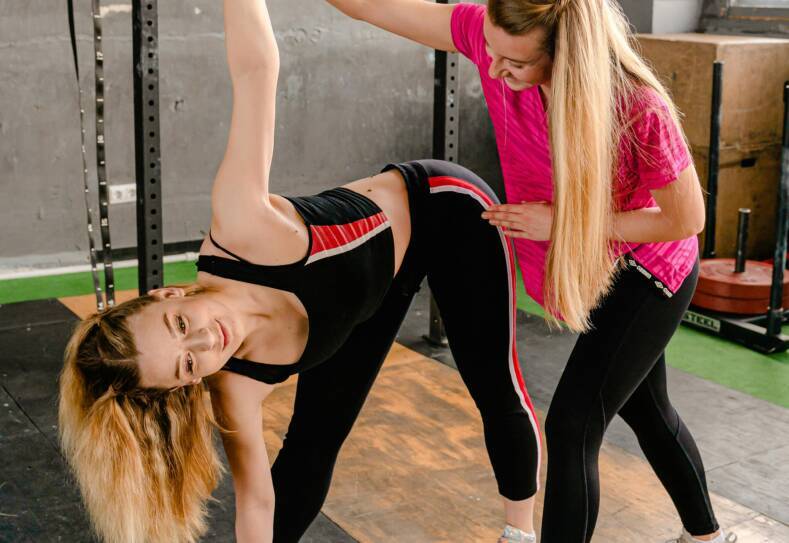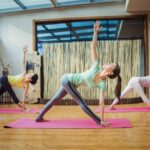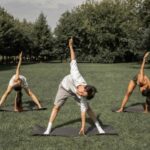Flexibility is a fundamental component of physical fitness that pertains to the range of motion available to the joints and the lengthening capability of muscles. It enables individuals to perform movements without strain or injury, facilitating everyday tasks as well as athletic activities. Flexibility is not only essential for athletes who require a wide range of motion for their sports but also for non-athletic people who seek to maintain or improve their level of physical function and reduce the risk of musculoskeletal injuries.
Including flexibility exercises in a fitness regimen can lead to several health benefits. Proper flexibility training can decrease the likelihood of experiencing tightness and soreness around joints, thus contributing to a healthier body posture, improved balance, and a decreased risk of falls, particularly as one ages. Furthermore, regular stretching can enhance other components of fitness by allowing for more effective workouts, promoting better circulation, and enabling more efficient movement patterns.
To maintain or improve flexibility, it is recommended that stretching exercises target all the major muscle groups, taking care to execute them with correct form and for an adequate duration. Adequate flexibility, though often overlooked, is an integral part of a well-rounded fitness program that includes aerobic exercise, strength training, core workouts, and balance training. Through consistent practice, flexibility can be maintained or improved, providing a foundation for overall physical well-being.
Understanding Flexibility
Flexibility is a crucial element of fitness, encompassing the range of motion of joints and the elasticity of muscle groups.
Defining Flexibility
Flexibility refers to the ability of a joint or series of joints to move through an unrestricted, pain-free range of motion. This attribute is dependent on the elasticity and length of the muscles and connective tissues that surround the joint. A higher level of flexibility can contribute to the efficient movement of muscles and joints, reducing the risk of injuries and improving performance in physical activities.
Components of Fitness
Within the realm of fitness, flexibility is recognized as one of the five health-related components. The other four include cardiovascular endurance, muscular endurance, muscular strength, and body composition. Flexibility is unique, as it is concerned with the limitations and capabilities of one’s joints and muscles, rather than cardiovascular or muscle power. Properly understanding and incorporating flexibility into a fitness regimen is integral, as it affects the overall harmony of the body’s movements.
- Joints: Areas where two or more bones meet, like elbows and knees.
- Muscle Groups: Collections of muscles which contribute to joint movement.
- Range of Motion (ROM): Degree of movement that a joint can achieve.
- Elasticity: The ability of muscles and connective tissues to return to their original state after being stretched.
| Components of Fitness | Description |
|---|---|
| Cardiovascular Endurance | The ability of the heart, lungs, and blood vessels to deliver oxygen to the body’s tissues during prolonged exercise. |
| Muscular Endurance | The ability of a muscle group to execute sustained contractions over time against resistance. |
| Muscular Strength | The peak force that a muscle can exert against resistance in a single effort. |
| Flexibility | The capacity of joints to move through their full range of motion; essential for general fitness and wellness. |
| Body Composition | The relative percentage of muscle, fat, bone, and other vital parts of the body. |
In focusing on flexibility, individuals can improve their physical performance and reduce the risk of activity-related injuries.
Importance of Flexibility in Fitness
Flexibility is a vital component of overall physical fitness, profoundly affecting one’s athletic performance and quality of life.
Benefits for Athletic Performance
Athletic performance is significantly enhanced by flexibility training. Athletes who invest time in improving their range of motion can experience:
- Improved Sport-Specific Movements: Greater flexibility facilitates a wider range of motion, which can lead to more effective and efficient movement patterns in various sports.
- Injury Prevention: Regular flexibility exercises can strengthen the muscles and tendons, leading to a reduced risk of strain or injury during athletic activities.
- Recovery: Enhanced flexibility may contribute to faster recovery post-exercise by decreasing muscle tightness and soreness.
Impact on Quality of Life
Flexibility extends its benefits beyond the realm of athletic endeavors to improve quality of life through:
- Reduced Pain and Discomfort: Regular stretching can alleviate muscle stiffness and joint discomfort, promoting better daily functioning and comfort.
- Increased Balance and Coordination: Flexibility training can improve proprioception—the body’s ability to perceive its position in space—thus enhancing balance and coordination.
- Positively Affects Health-Related Components: As an integral part of health-related fitness components, flexibility contributes to better posture, reduced risk of falls, and the maintenance of joint health.
Flexibility and the Aging Process
Flexibility is crucial for maintaining mobility and reducing the risk of falls and injuries as people age. Over time, muscles and connective tissues lose elasticity, which can lead to decreased range of motion and impact a person’s capacity to perform everyday activities.
Maintaining Mobility with Age
As individuals grow older, their muscle strength and muscular endurance tend to decline. This natural progression can lead to a reduction in flexibility and mobility. Engaging in regular physical activity that includes flexibility exercises is essential for preserving range of motion. Activities such as yoga, Pilates, and targeted stretching routines are beneficial for sustaining muscular health and preventing the loss of flexibility associated with aging.
Key strategies for maintaining flexibility:
- Consistent stretching: Incorporate stretching into daily routines.
- Physical activities: Pursue hobbies or exercises that naturally include flexibility components.
- Professional guidance: Seek advice from physiotherapists or fitness experts to receive personalized flexibility programs.
Preventing Falls and Injuries
Flexibility plays a vital role in fall and injury prevention, especially for aging populations. High risk of injury from falls is a significant concern for those experiencing decreased flexibility and balance. Through the implementation of regular flexibility training, older adults can help preserve their balance and coordination, which are key factors in reducing the incidence of falls.
List of flexibility-related fall prevention tips:
- Stretch regularly: Focus on exercises that enhance stability and flexibility of lower extremity joints.
- Balance exercises: Practice tai chi or similar balance-focused activities to improve proprioception.
- Safe environment: Modify living spaces to reduce fall risks, such as removing tripping hazards and ensuring adequate lighting.
By integrating flexibility exercises into their weekly routine, older adults can effectively combat the adverse effects of the aging process on mobility, thus protecting themselves against the increased risk of injury.
Flexibility Training Techniques
Flexibility training utilizes various techniques to improve the muscle’s ability to elongate and enhance the range of motion in the joints. It decreases the risk of injuries and can alleviate tightness and soreness. Such training not only benefits athletes but also enhances daily functioning for individuals of all fitness levels.
Static Stretching
Static stretching involves extending a muscle to its farthest point and then holding that position for a period, usually 15 to 30 seconds. It is critical to perform static stretches when the muscles are already warm to prevent strains. Flexibility exercises involving static stretching should be repeated two to four times, accumulating 60 seconds per stretch to ensure effectiveness.
- Frequency: Aim to include static stretches in your routine at least 3 days per week post-workout.
- Yoga and Pilates: These disciplines often incorporate static stretching in their practices, offering structured ways to improve flexibility.
Dynamic Stretching
Dynamic stretching incorporates movement into the stretch itself. Unlike static stretching, where one holds a position, dynamic stretching involves moving parts of your body and gradually increasing reach, speed, or both. This type of stretching warms up the muscles, making it an excellent precursor to more intense physical activity.
- Examples: Leg swings, arm circles, and torso twists.
- Recommendation: A dynamic stretching routine can be done prior to exercise to prepare the body for movement and enhance muscular performance.
Functional Movement Systems
Functional movement systems are designed to assess and develop the body’s natural movement patterns. Through these systems, individuals enhance their movement efficiency, which can contribute to better flexibility and reduced likelihood of injury.
- Functional Exercises: Include multi-joint movements that can range from simple activities like squats to more complex exercises tailored to one’s daily or sporting needs.
- Integration with Training: Functional movements should be integrated into an overall training program to complement static and dynamic stretching, as well as to support the strength and stability of the musculoskeletal system.
Incorporating Flexibility into a Fitness Regimen
Flexibility training is an essential facet of a comprehensive fitness program, catering to the improvement of full range of motion and reducing the risk of injury. It complements other fitness components such as cardiovascular endurance, muscular strength, and strength training.
Structuring a Flexibility Routine
A well-constructed flexibility routine should begin with warm-up exercises to elevate body temperature and prepare the muscles for stretching. Following the warm-up, stretching exercises targeting all major muscle groups can be performed. These should involve static stretches maintained for 15-30 seconds, ensuring that each muscle is stretched to the point of mild discomfort, not pain.
- Frequency: Ideally, flexibility exercises should be done daily or at least three times a week.
- Intensity: Stretches should be held just beyond the normal range of motion, without causing pain.
- Time: Each stretch should be held for 15 to 30 seconds and repeated 2 to 4 times, accumulating 60 seconds per stretch.
Incorporating dynamic stretching, involving movement and functional patterns, can also be beneficial, especially before engaging in activities that require a high degree of mobility.
Integrating Flexibility with Other Fitness Components
Flexibility training should synchronize with the other key components of a fitness regimen. Post-strength training, when muscles are already warm, is an ideal time to perform static stretching exercises to enhance muscular relaxation and development. Similarly, following cardiovascular activities, flexibility work can aid in cooling down and refocusing on breathing.
By dovetailing flexibility exercises with other workouts, individuals can expect:
- Improved performance in strength and cardio exercises due to a fuller range of motion.
- Decreased likelihood of muscle imbalances that can arise from strength training.
- Enhanced recovery post-exercise by promoting blood flow and reducing muscle soreness.
In summary, incorporating flexibility into a fitness routine fosters a symbiotic relationship with other exercises, contributing to a holistic approach to health and fitness.
Assessing Flexibility and Setting Goals
Flexibility, crucial for overall fitness, involves the range of motion (ROM) around a joint. Effective assessment can guide the setting of realistic goals for improvement.
Measuring Flexibility
To measure flexibility accurately, one must consider the range of motion (ROM) of joints. A common tool for this purpose is the sit-and-reach test, which assesses the flexibility of the lower back and hamstring muscles. The test’s validity and reliability have been acknowledged by reputable organizations such as the American Council on Exercise (ACE). Participants are instructed to sit with legs extended and reach forward as far as possible, typically towards a box or a measuring device. The distance reached is recorded, providing a concrete measurement of flexibility.
Joint range of motion can also be measured using a goniometer. A goniometer assesses the ROM in a specific joint, such as the knee or shoulder, offering a detailed view of flexibility in that region. Both these methods should be conducted by a trained professional to ensure accuracy.
Realistic Target-Setting for Improvement
Setting realistic targets for flexibility improvement requires a personalized approach. Goal setting should follow the SMART criteria:
- Specific: Define which joints or areas of flexibility one wishes to improve.
- Measurable: Set benchmarks using initial flexibility assessments.
- Attainable: Ensure the targets are achievable based on individual capabilities.
- Relevant: Goals should align with one’s fitness or daily activity requirements.
- Time-based: Establish a time frame for achieving these objectives, allowing for gradual progress.
For example, if an initial assessment shows a sit-and-reach score of 15 inches, a realistic target might be to increase this measure by 1 inch within a six-week timeframe. Progress should be regularly reassessed, and goals adjusted as necessary to maintain both motivation and continued improvement.
Common Flexibility Challenges and Solutions
In pursuit of improved flexibility, individuals commonly face issues such as muscle and joint stiffness, and plateaus in flexibility gains. Addressing these challenges effectively can lead to better physical health and reduced risk of discomfort or injury.
Dealing with Muscle and Joint Stiffness
Muscle and joint stiffness often result from a sedentary lifestyle, chronic disease, or even normal aging. To combat this issue, one should:
- Incorporate dynamic stretching: Before exercise, perform dynamic stretches to warm up the muscles, which can enhance elasticity and reduce stiffness.
- Practice static stretching: After workouts, engage in static stretching where one holds a stretch for 20-30 seconds to improve muscle length and flexibility.
For those experiencing back pain or joint pain, particularly in the lower back, incorporating stretches that target these areas is key. Gentle yoga or tailored physical therapy exercises can alleviate tension and promote flexibility.
Overcoming Plateaus in Flexibility Gains
Hitting a plateau in flexibility can be discouraging, but it can be overcome by:
- Diversifying techniques: Incorporate a variety of stretching techniques, such as PNF (proprioceptive neuromuscular facilitation) to provide new stimuli to the muscles.
- Increasing intensity: Gradually increase the intensity or duration of stretches to challenge the muscles. However, one should be cautious to avoid muscle fatigue or injury.
To prevent injury, a consistent and careful approach should be taken when intensifying flexibility training. For those with chronic disease, it’s important to consult a healthcare provider before making significant changes to their exercise routine.








